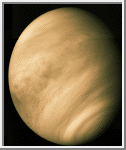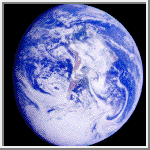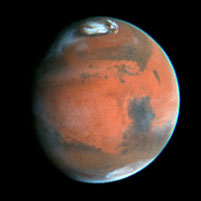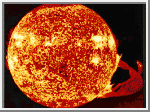You have just seen the outer planets now lets look closer in to our home world with the four inner planets. The planets are divided in two groupes the inner and outter planets. The outter planets are mostly giant balls of gas, the inner planets are mostly rock with little or no atmosphere. Our home planet Earth is one of the inner planets it is the third from the sun. Most people now a lot about our home,but what of the other three? Well you will know a little about them when you venture through this page.

Mercury, the planet nearest the sun is a hot,dry and airless planet. To look at Mercury you would think that you see the moon,Mercury has many impact craters like the moon and isn't much bigger.Its gravitational field is too weak,compared to the sun's mighty pull to hold on to any gasses, so it has no atmosphere.
The sun looking twice as large from Mercury as it seems from Earth glares down on Mercury for a day that is as long as 88 days on Earth dew to its slow rotation. At noon,Mercurys surface temperature is 800 f., and in the middle of the equally long night the temperature dip to -300 f.the largest temreature change of any planet in the solar system.

The second planet from the sun, Venus is Earth's nearest neighbor and almost matching Earth in size. Early astronomers imagined Venus as a lush paradise and called it earths twin. But recent space probes have given a very differnt picture. Within it's thick atmosphere, Venus is the hottest planet in the solar system and is bathed in a drizzle of sulfuric acid, a corrosive mixtuer of sulfer,hydrogen and oxygen. On the surface the atmosphere is as heavy and dense as the water at the bottom of the ocean at a depth of 3,000 feet. Scientist doubt that any life forms will be found on Venus.

the planet that you and I live on, the planet Earth, is the third planet from the sun and the only know planet that supports life. Very rich in Oxygen an essential gas for life and ammino acids the very biulding blocks of life itself, it is also the only planet know with vast amounts of liquid water. light from the sun at a distance of 93,000,000 miles only takes seven minutes to reach earth . Earth formed some 4.6 billion years ago from the same nebulus cloud of stellar matter as the sun and all other planet in the solar system.

Mars is the fourth planet from the sun and one of Earths neighbors. Mars glows with a reddish light in the night sky. Though half as big as Earth, Mars day is 37.5 minutes longer than Earth's because mars rotates more slowly. Its axis is tilted like Earth's axis, so mars also has summer and winter seasons. But its atmosphere is thin and contains mostly carbon dioxide, and its surface is always well below freezing. Soil tests by two viking missions in 1976 showed that Iorn-Oxide {rust} is the reason for the red planets color. Recent space probes have entered orbit around mars and a lander has traveled the surface of mars in search of life. No luck yet....

The Sun, master of the solar system, is the one reason the solar system even exist. It's mighty gravitational pull holds the planets in orbit. Each planet orbits the sun at different speeds according to there distance from the sun and there mass. the speed is needed to keep the suns mighty pull from dragging the planets into it's firey disk.
Sunlight pours forth from the sun's intierior at a speed of 186,000 miles per second, or about 670 million miles per hour, giving life to all of Eath's organisims. A swirling cloud of gas near the edge of the milky way galaxy gave birth to the sun some 4.6 billion years ago. Today, it is a medium-size star, composed largely of hydrogen and helium. At the sun's core, which burns at 15 million degreesKelvin,pressure converts hydrogen nuclei to helium, producing vast amounts of enegry in a prosses called nuclear fusion. The energy rises and, coupled with the sun's rotation and magnetic forces, keeps the surface churnning and sizzling. In about 5 billion years the sun will begin a slow death, first exspanding up to 100 times it's pressent size {it's over 800,000 miles at it's equater now}then collapsing untill it is a 100 times smaller than it is today. It's fires burned out, the Sun will become a cold black cinder.



